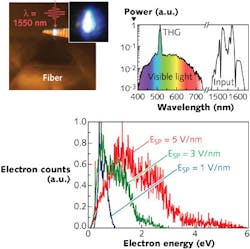Two researchers, Shawn Sederberg and Abdulhakem Elezzabi, at the University of Alberta (Edmonton, AB, Canada) have shown for the first time that electrons excited via light in a nanoscale silicon waveguide can be accelerated to energies of up to several electron volts by the strong-field ponderomotive potential that exists in the highly confined plasmonic field.1 One result is a strong white-light emission from the silicon waveguide, even though silicon is an indirect-bandgap material and does not normally emit white light.
The nanoplasmonic silicon platform, which is CMOS-compatible, operates in the 1550 nm wavelength region and occupies an ultracompact square footprint that is 0.43 μm2. The waveguides themselves are 100 nm wide and 340 nm high and capped with a 60-nm-thick gold film. They are excited by end-firing laser pulses with an 84 ps duration into the waveguides using a microscope objective; the resulting electric fields range up to 5 V/nm.
Electron avalanche
As they propagate down the waveguide, the femtosecond pulses excite free carrier electrons via two-photon absorption (TPA), which then accelerate ballistically (some of them to energies above the impact-ionization energy Et) and eventually collide with valence-band electrons. If their energies are <Et when they collide, some electrons emit a photon. If their energies are >Et, they dislodge another electron. The result is an electron avalanche, along with wideband light emission between 375 and 650 nm and a third-harmonic signal that spans 500 to 530 nm (see figure). The white-light output is collected into a single-mode optical fiber.
“The exponential growth of visible light emission confirms the exponential growth of the electron population, demonstrating the presence of an optical-field-driven electron avalanche,” says Elezzabi. He notes that the impact-ionization process is similar to the phenomenon that occurs in avalanche-driven semiconductor diodes, except for the fact that it is light and not an applied electric field that is accelerating the electrons.
The researchers also showed via ultrafast pump-probe time-domain spectroscopy that such electrons not only are accelerated, but they are also swept away inside the semiconductor by the nanoplasmonic field on a time scale of the order of a picosecond. This time scale corresponds to the expected sweeping time defined by how long it takes the electrons to travel far enough from the gold/silicon plasmonic interface that they stop interacting with the probe.
“The high sensitivity of the electron avalanche process will enable the development of compact, sensitive optical circuitry and interfacing between nanoplasmonic and electronic components,” says Elezzabi. “These findings offer a means to harness the potential of the emerging field of nonlinear nanoplasmonics. To our knowledge, the experimental demonstration of electrons gaining energy form an optical field in semiconductors presents new physics that will open up new opportunities for nanoplasmonic devices.”
REFERENCE
1. S. Sederberg and A. Y. Elezzabi, Phys. Rev. Lett. 113, 167401, October 14, 2014; doi: 10.1103/PhysRevLett.113.167401.

